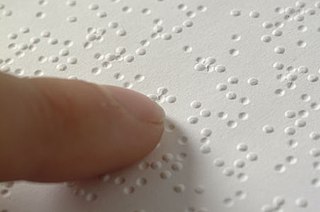
Braille is a tactile writing system used by people who are visually impaired, including people who are blind, deafblind or who have low vision. It can be read either on embossed paper or by using refreshable braille displays that connect to computers and smartphone devices. Braille can be written using a slate and stylus, a braille writer, an electronic braille notetaker or with the use of a computer connected to a braille embosser.

The Polish alphabet also abecadło is the script of the Polish language, the basis for the Polish system of orthography. It is based on the Latin alphabet but includes certain letters with diacritics: the kreska or acute accent ; the overdot or kropka (ż); the tail or ogonek ; and the stroke (ł). The letters q, v and x, which are used only in foreign words, are usually absent from the Polish alphabet. However, prior to the standardization of the Polish language, the letter "x" was sometimes used in place of "ks".

New York Point is a braille-like system of tactile writing for the blind invented by William Bell Wait (1839–1916), a teacher in the New York Institute for the Education of the Blind. The system used one to four pairs of points set side by side, each containing one or two dots. The most common letters are written with the fewest points, a strategy also employed by the competing American Braille.

(Mainland) Chinese Braille is a braille script used for Standard Mandarin in China. Consonants and basic finals conform to international braille, but additional finals form a semi-syllabary, as in zhuyin (bopomofo). Each syllable is written with up to three Braille cells, representing the initial, final, and tone, respectively. In practice tone is generally omitted as it is in pinyin.
Tibetan Braille is the braille alphabet for writing the Tibetan language. It was invented in 1992 by German socialworker Sabriye Tenberken. It is based on German braille, with some extensions from international usage. As in print, the vowel a is not written.

Russian Braille is the braille alphabet of the Russian language. With suitable extensions, it is used for languages of neighboring countries that are written in Cyrillic in print, such as Ukrainian and Mongolian. It is based on the Latin transliteration of Cyrillic, with additional letters assigned idiosyncratically. In Russian, it is known as Шрифт Брайля.
Greek Braille is the braille alphabet of the Greek language. It is based on international braille conventions, generally corresponding to Latin transliteration. In Greek, it is known as Κώδικας Μπράιγ Kôdikas Brég "Braille Code".
The goal of braille uniformity is to unify the braille alphabets of the world as much as possible, so that literacy in one braille alphabet readily transfers to another. Unification was first achieved by a convention of the International Congress on Work for the Blind in 1878, where it was decided to replace the mutually incompatible national conventions of the time with the French values of the basic Latin alphabet, both for languages that use Latin-based alphabets and, through their Latin equivalents, for languages that use other scripts. However, the unification did not address letters beyond these 26, leaving French and German Braille partially incompatible and as braille spread to new languages with new needs, national conventions again became disparate. A second round of unification was undertaken under the auspices of UNESCO in 1951, setting the foundation for international braille usage today.
Armenian Braille is either of two braille alphabets used for writing the Armenian language. The assignments of the Armenian alphabet to braille patterns is largely consistent with unified international braille, with the same punctuation, except for the comma. However, Eastern and Western Armenian are assigned braille letters based on different criteria. The conventions for Western Armenian were developed in Lebanon.
Dutch Braille is the braille alphabet used for the Dutch language in the Netherlands and in Flanders.
Turkish Braille is the braille alphabet of the Turkish language.
Several braille alphabets are used in Nigeria. For English, Unified English Braille has been adopted. Three other languages have been written in braille: Hausa, Igbo, and Yoruba. All three alphabets are based on English readings, with the addition of letters particular to these languages. Punctuation is as in English Braille.
According to UNESCO (2013), there are different braille alphabets for Urdu in India and in Pakistan. The Indian alphabet is based on national Bharati Braille, while the Pakistani alphabet is based on Persian Braille.
Several braille alphabets are used in Ghana. For English, Unified English Braille has been adopted. Four other languages have been written in braille: Akan (Twi), Ga, Ewe, and Dagaare. All three alphabets are based on the basic braille letter values of basic Latin alphabet:
The braille alphabet used for the Kazakh language is based on Russian Braille, with several additional letters found in the print Kazakh alphabet.
Faroese Braille is the braille alphabet of the Faroese language. It has the same basic letter assignments as the Scandinavian Braille and is quite similar to the Icelandic Braille.
Guarani Braille is the braille alphabet of the Paraguayan Guarani language. Letter assignments are those of Spanish Braille : that is, the basic braille alphabet plus ⠻ for ñ. An additional letter, ⠒, is used for glottal stop, written as an apostrophe in the Guarani print alphabet. Print digraphs such as ch and rr are digraphs in braille as well. In addition, the tilde in print is written as the letter ⠱ in braille, and comes before the letter it appears on in print. Thus the Guarani letters outside the basic Latin alphabet are:
Q'ari is the 27th letter of the three Georgian scripts.
Chini is the 29th letter of the three Georgian scripts.
Ch'ari is the 33rd letter of the three Georgian scripts.





